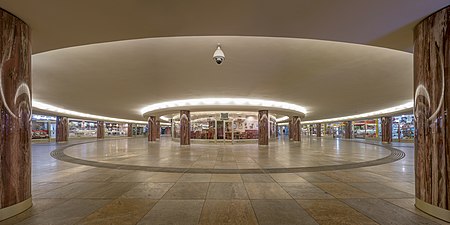Opernpassage

The Opernpassage (Opera passage) in the Inner City of Vienna is a Grade II listed pedestrian underpass under the ring road (Ringstraße). It was opened in 1955, a day before the re-opening of the nearby Vienna State Opera.Designed by architect Adolf Hoch it has been a symbol of a modern spirit in architecture and urban planning. After more than 50 years the City of Vienna undertook a complete restoration of the structure, advised by the Federal Office for the Protection of Monuments in Austria. The passage was reopened on 17 September 2013. It shows the original design of the round columns, the curved glass of the shop windows, and the chequerboard pattern of the floor.The artwork Pi by Canadian artist Ken Lum is installed on the walls of the western branch of the pedestrian passage since 2006.
Excerpt from the Wikipedia article Opernpassage (License: CC BY-SA 3.0, Authors, Images).Opernpassage
Kärntnertorpassage, Vienna Innere Stadt (Wieden)
Geographical coordinates (GPS) Address Nearby Places Show on map
Geographical coordinates (GPS)
| Latitude | Longitude |
|---|---|
| N 48.2016 ° | E 16.3693 ° |
Address
Kärntnertorpassage
Kärntnertorpassage
1010 Vienna, Innere Stadt (Wieden)
Austria
Open on Google Maps










